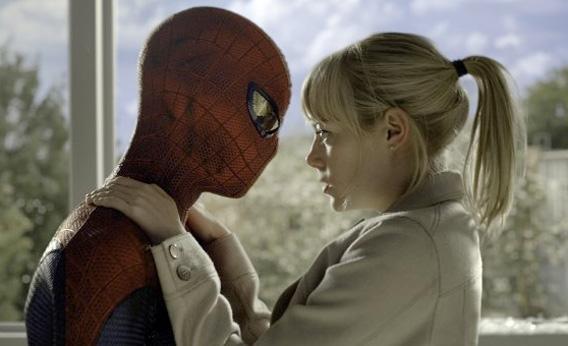You know what Spider-Man movie I’d like to see? (Given that there has to be one every five years, which I guess, constitutionally, there now does.) I’d like to see Tobey Maguire as the puny-youth-turned-masked-vigilante Peter Parker, and Kirsten Dunst as his true love Mary Jane Watson, show us the Spidermans as a thirtysomething couple. Would they have Spider-kids? How would a decade of adulthood have changed them? Would they still kiss upside down?
There are situations, I guess, where a “franchise reboot” could feel like something other than a naked grab for dollars: For example, if a recent attempt at adapting the property has conspicuously flopped (as Ang Lee’s Hulk did in 2003, making the 2008 remake with Ed Norton seem somehow less egregious), or if a director has a distinctive vision to bring to the story (as has been the case with Christopher Nolan’s moody Batman films, which love them or hate them, are their own thing). But to try to sell us another matched set of Spider-Man films only a decade after Sam Raimi’s well-regarded and commercially successful Spider-Man, and only five years since that series ended with the disappointing Spider-Man 3? It’s hard not to smell planned obsolescence, even before you’ve read the depressing business backstory about how Sony needed to make a Spider-Man movie, any Spider-Man movie, to keep the rights to the character from reverting to Disney/Marvel. With a burning lack of vision, Sony has chosen to re-cast and re-tell, essentially, the same story we all just heard in 2002: How the young, unprepossessing Peter Parker went from Queens-dwelling schmo to skyscraper-scaling wonder arachnid, and got the girl to boot.
In The Amazing Spider-Man, directed by (500) Days of Summer’s Marc Webb, the young Peter Parker is played by the 28-year-old (but much younger-looking) American-English actor Andrew Garfield, best known to American audiences as Eduardo Saverin, the duped business partner of Mark Zuckerberg in The Social Network (2010.) Though Garfield’s presence isn’t enough to justify the existence of this pleasant but uninspired retread, he’s an exciting actor to watch: slenderer and more graceful than your usual action hero, with deep-set brown eyes, matinee-idol eyebrows and a dryly self-effacing (but not at all emasculated) charm. Garfield’s high-school-aged Peter Parker isn’t that different in conception from Tobey Maguire’s pizza-delivering college student, but he gives the character a slightly sexier, darker edge. The central (not that funny) joke of Spider-Man 3 revolved around how out of character it would be for Maguire’s super-persona to do anything even remotely bad. In this version, the hero-to-be is actually something of a screw-up from the start, petulantly rejecting the loving guidance of his adoptive parents Uncle Ben (Martin Sheen) and Aunt May (Sally Field), and naively helping an unscrupulous scientist, Dr. Curt Connors (Rhys Ifans) to develop a genetic therapy that combines human and animal DNA in a single organism.
During a tour of the ultra-high-tech headquarters where Connors works, Peter makes a forbidden detour into a room that houses a “bio-reactor” (rendered, in a fanciful bit of production design, as a huge semi-transparent tube lined with innumerable spiderwebs, each with its own resident). Later that same day, Peter wakes from a deep sleep on the subway with inexplicable new powers. There follows a cleverly choreographed action scene on the subway car, in which a suddenly mighty Peter accidentally creates havoc among his fellow riders. But most of the action that follows feels like something we’ve seen before, all too recently. Those moments when Spider-Man first swings from building to building, exploring the rush that accompanies his newfound physical prowess, are effective in their way—especially in 3D, where Spidey’s web swoops imitate the stomach-dropping sensation of a carnival ride. But having just accompanied Peter through the whole acquisition-of-superpowers-as-a-metaphor-for-adolescence thing, it’s hard to muster the energy to rehearse it again. He’s exhilarated by his changing body. The web-shooting hands are a masturbation metaphor. We get it.
Perfunctory as this film’s gestures toward originality may be, The Amazing Spider-Man does what it does pretty well. Ifans, the gaunt, sad-eyed Welsh actor, is well cast as the Faustian Dr. Connors, who late in the film undergoes a Cronenberg-tinged multi-stage transformation into a reptilian villain called The Lizard. (The Lizard’s ultimate goal: to create more of his own kind by releasing a gene-mutating gas into the atmosphere, resulting in mass lizardification of the populace.) And Peter’s love interest, Gwen Stacy, as played by the husky-voiced Emma Stone, is the stuff of a comic nerd’s dreams: a sweet, smart, wisecracking dame in demure sweaters, miniskirts, thigh-high stockings and boots. (She’s only modest about her upper body, I guess.) The scenes in which Peter sneaks up the fire escape to Gwen’s bedroom behind the back of her strict police-captain dad (Denis Leary) convincingly evoke the thrill of teenage lust (apparently Garfield and Stone are now an item in real life, which could account for the crackle we feel between them onscreen). The Amazing Spider-Man also avoids the common comic-book adaptation trap of gloomy self-seriousness, and until the inevitable action-crammed last act, it moves along at a reasonable clip. This might be a fun summer blockbuster if only it even remotely needed to exist.
